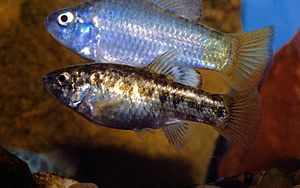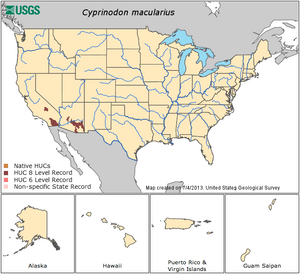Desert pupfish facts for kids
Quick facts for kids Desert pupfish |
|
|---|---|
 |
|
| Conservation status | |
| Scientific classification | |
| Synonyms | |
|
The desert pupfish (Cyprinodon macularius) is a special type of bony fish. It belongs to the Cyprinodontidae family. This small fish is usually less than 7.62 cm (3 in) long. Male pupfish are often bigger and have bright blue colors. Females and young fish are silvery or tan.
What makes the desert pupfish amazing is its ability to live in very tough places. It can survive in water that is super salty, has strange pH levels, or is very hot. It can also live where there's not much oxygen.
Sadly, the desert pupfish is an endangered species in the United States. It used to be common but has disappeared from most of its old homes. This started happening in the early 1900s. Its homes were destroyed or broken up. Also, new fish like tilapia eat them or take over their space. Today, you can only find natural groups of desert pupfish in a few spots. These are near the Salton Sea in California and the Colorado River Delta in Baja California and Sonora, Mexico.
Contents
About the Desert Pupfish
The desert pupfish was first described by scientists Spencer Baird and Charles Girard in 1853. At first, people thought there were three types of this fish. But later studies showed they were actually three different species.
Scientists looked at the mitochondrial DNA of these fish. They found that the pupfish from the Rio Sonoyta Basin and the pupfish from the Salton Sea had been evolving separately for a long time. This means they became different species about 100,000 years ago. So, the three types are now known as:
- the desert pupfish (C. macularius)
- the Sonoyta (Quitobaquito) pupfish (C. eremus)
- the Santa Cruz (Monkey Spring) pupfish (C. arcuatus)
What Does It Look Like?
The desert pupfish is a small fish, usually shorter than 7.62 cm (3 in). Males are bigger than females. They also have brighter colors, especially when it's time to breed.
Females and young pupfish are usually tan or olive on their backs. Their sides are silvery with thin, dark stripes. These stripes sometimes look broken. During mating season, male pupfish turn bright blue on their heads and sides. Their tail fin and the area near it become yellow or orange.
The pupfish has a smooth, rounded back. Its body is thick and flat on the sides. It has a mouth that sticks out, with special teeth that have three points.
Where Do They Live?

Desert pupfish live in shallow water in desert springs, small streams, and wet areas called marshes. They are found below 1,524 meters (5,000 ft) in height. These fish can handle very salty water, high temperatures, and low oxygen levels better than most fish. This means they can live in places where other fish cannot survive.
Pupfish like clear water with plants, slow water flow, or sandy bottoms. They do well if there isn't much plant life, except for mats of algae on the bottom.
Historically, the desert pupfish lived in a wide area. This included the lower Colorado River in Arizona and California, all the way to the Gulf of Mexico. They were also found in the Salton Sink basin in California and the Gila River basin in Arizona and Sonora.
Today, there are fewer places where you can find them. In the United States, they are mainly in two small rivers and some pools near the Salton Sea in California. In Mexico, they are spread out along the Colorado River Delta. There are 11 known groups of wild desert pupfish in the United States and Mexico. People have also tried to put them back into other areas. There are now 16 groups in Arizona and 46 groups in captivity or special safe places.
What Do They Eat?
Pupfish are omnivores, meaning they eat both plants and animals. They look for food in shallow water early in the morning and late in the evening. During the day, when the water gets very hot (36 °C or more), they move out of the shallow areas to avoid getting too hot.
They like to eat tiny swimming creatures, like nekton. They can even get rid of mosquito groups in an area! If there are no mosquitoes, pupfish will eat other things. These include chironomid midges (small flies), algae, small invertebrates, tiny crustaceans, insect larvae, snails, and dead bits of plants and animals. Sometimes, they even eat the eggs and young of their own kind.
Pupfish eggs that are left out in the open are often eaten by other pupfish. But if the baby fish are moving, adults usually leave them alone unless they are very hungry.
Life and Behavior
Movement Patterns
Desert pupfish have special ways of moving. Here are a few:
- Meandering: The female swims slowly and a bit aimlessly in the middle of the water or near the surface.
- Nuzzling: The male swims right under the female, tilting his body up. He keeps his head near her belly.
- Contacting: The male stays close to the female, often touching her side as she moves slowly.
- Tilting and Nipping: The female tilts her body down towards the bottom. She might pick up some sand or dirt with her mouth, then drop it. This might be a way of looking for food or a signal for breeding.
- S-shaping: When seen from above, the pupfish bends its body into an "S" shape. Both males and females do this when mating.
- Jerking: While in an "S" shape, the pupfish quickly moves its head. This causes its body to twitch. During this jerk, the female lays an egg, and the male fertilizes it.
- Patrolling: A male pupfish will swim quickly in short bursts, then stop, then swim in another direction. He does this to guard his territory.
- Fleeing: A pupfish swims very fast to hide, or to the water's surface if there's no cover.
- Escaping: A pupfish might dive into the sand or mud at the bottom and stay still.
Reproduction and Life Cycle
Desert pupfish usually breed from early spring into winter. This happens when the water temperature is above 20 °C. If there's plenty of food and the temperature is right, pupfish can start breeding when they are as young as six weeks old. Most pupfish, however, wait until their second year to reproduce.
During breeding season, male pupfish set up and protect their own areas. These areas are usually less than 1 meter deep and 1–2 meters wide. The size of the area depends on the male's size, how many other males are around, and the water temperature. Females swim in groups and look for food. When a female is ready to lay eggs, she will go into a male's territory.
The breeding process is very specific. Males stay in their territory, and females visit them. If only one female comes, they start breeding right away. If many females are there, the male will swim from one to another until he finds one ready to breed.
Spawning can last from 30 minutes to 2 hours. Larger females lay more eggs. The last time the fish connect is usually the longest, and several eggs are laid one after another. When the female is done, she swims away quickly, and the male might chase her for a few minutes. Then, both fish go back to looking for food.
Surviving Extreme Conditions
Desert pupfish are amazing because they can handle very tough conditions. They can live in temperatures from about 4º to 45 °C. They can also survive in water that is very salty, from fresh water to water that is 70 parts per thousand salt. This is much more than almost any other freshwater fish can handle!
They can also live with very little dissolved oxygen, as low as 0.13 parts per million. Pupfish are often found in places with lots of plants, high pH, high saltiness, and low oxygen. This suggests that living in these extreme places helps them survive because other fish that might compete with them or eat them cannot live there.
Helping the Desert Pupfish
The desert pupfish was listed as endangered in 1986. Since then, many people have worked to save it. The biggest dangers to the pupfish are:
- Habitat destruction: Their homes are lost or damaged by things like pumping water from the ground or changing how water flows.
- Pollution: Water can get dirty from farm runoff and other things.
- New species: Fish that are not native to the area can bring diseases, eat the pupfish, or compete with them for food and space.
To help the desert pupfish, people are doing several things:
- Controlling new species: Managing or removing fish that don't belong in the pupfish's habitat.
- Protecting water: Making sure water levels and quality are good in ponds, springs, and drains.
- Restoring habitats: Fixing damaged areas where pupfish live.
- Creating safe places: Setting up large, protected groups of pupfish in special refuges.
Putting pupfish back into wild habitats has had some success. Creating captive or refuge groups has worked even better. Managing water resources is seen as the most important way to help the desert pupfish survive.
Images for kids
See also
 In Spanish: Cyprinodon macularius para niños
In Spanish: Cyprinodon macularius para niños




